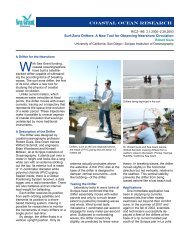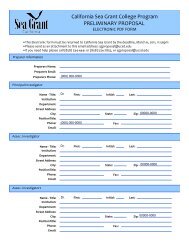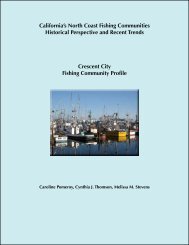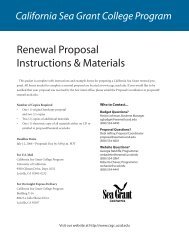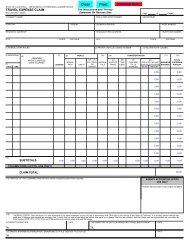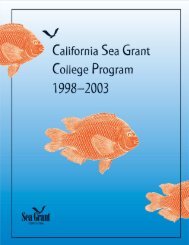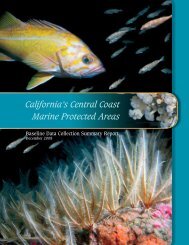2001â2002 - California Sea Grant - UC San Diego
2001â2002 - California Sea Grant - UC San Diego
2001â2002 - California Sea Grant - UC San Diego
You also want an ePaper? Increase the reach of your titles
YUMPU automatically turns print PDFs into web optimized ePapers that Google loves.
of the alpha subclass of proteobacteria. His conclusion: these<br />
proteobacteria must play a key role in protecting eggs. And, he speculates<br />
that their common bacterial-defense mechanism has probably remained<br />
relatively unchanged during the many millions of<br />
years it took for different squid species to evolve and<br />
geographically separate.<br />
Though similarities abound, Epel also reported<br />
some intriguing differences in the symbiotic bacteria<br />
associated with each species. Whereas none of the<br />
individually cultured symbiotic bacteria on the<br />
market squid produced antibiotic compounds, two of<br />
the other three species did: Sepia officinalis and S.<br />
pharaonis. In ongoing <strong>Sea</strong> <strong>Grant</strong> research, Epel is<br />
collaborating with marine natural chemist Dr.<br />
William Fenical of Scripps Institution of Oceanography,<br />
also a <strong>Sea</strong> <strong>Grant</strong> researcher, to purify and<br />
identify antibiotic molecules produced by these<br />
bacteria.<br />
So, how then does the market squid protect its<br />
eggs? The leading theory is that the complex suite of<br />
bacteria must be present to mount a response against<br />
infection. In this scenario, the mechanism for<br />
defense is called quorum sensing, meaning that key<br />
bacteria must be present in sufficient numbers to interact with each other<br />
and produce antibiotics.<br />
“While the public may retain its<br />
faith in an antibiotic shield against<br />
infection, in reality, for every class<br />
of antimicrobial drugs developed by<br />
the pharmaceutical industry,<br />
there’s a mechanism of resistance<br />
before much time elapses.<br />
Therapies once standard for<br />
infections have become largely<br />
ineffective.”<br />
—A 1999 report from an advisory<br />
panel convened by the National<br />
Institutes of Health, National<br />
Institute of Nursing Research<br />
To test this, Epel is collaborating with a researcher at the University of<br />
Iowa who has developed a technique for detecting what are known as acylhomoserine<br />
lactones, signal molecules associated with communication<br />
between proteobacteria. That is a fancy way of<br />
saying Epel is out to learn “who is talking to whom<br />
and in what language.” The idea, he explained, is<br />
that bacteria emit chemical signals that stimulate<br />
other bacteria to produce antibiotics or fungicides.<br />
If this novel form of antimicrobial defense is<br />
indeed what is happening, it could mean that<br />
these antibiotic compounds are also working<br />
through novel biochemical pathways. This, he<br />
said, offers the best chance against supergerms.<br />
Long-time <strong>Sea</strong> <strong>Grant</strong> researcher David Epel is<br />
the Jane and Marshall Steel, Jr. Professor in<br />
Marine Sciences Cell and Developmental<br />
Biology at Stanford. Photo: Stanford University<br />
23



